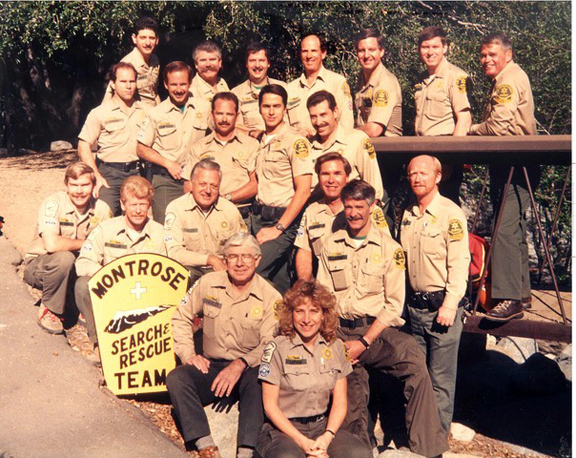The Women of the Montrose Search and Rescue Team
By Mary O’KEEFE
In 1970 women were employed as deputies with the Los Angeles County Sheriff’s Dept. but they were not yet allowed to go on patrol. That changed two years later when a pilot program began that trained women to be patrol deputies. In the 1980s, women were making strides in the business world but it was still not commonplace to see a female law enforcement officer. It was at this time that two local women decided they were going to join Montrose Search and Rescue.
“We never thought about being the first women,” said Sue Lapham who joined the team in 1981 just a few months after Debbie Longo. “We did our training together.”
The two became good friends; in fact, best friends who still stay in touch though Longo has moved from the area.
“I write her a couple of times a week, some [weeks] every day,” Lapham said.
Lapham did not know Longo until they met on the team. Lapham’s interest in MSR came from a personal experience. Her brother and sister were lost on Mt. Lukens and rescued by the MSR team.
“That was in 1971. The rescue made a huge impression on my life,” she said. “The rescue is how I became aware of the team. I volunteered for a [local] church group and invited one of the [MSR] guys to come and talk to the youth group.”
After the talk he said if she was interested in MSR, she should come to one of the meetings.
“Debbie was going through the process [of being accepted onto the team],” Lapham said of the first meeting she attended.
She began training and found that being a woman may have changed her approach but not the result.
“It was about the technique. Once you learned the technique you didn’t have to be a super strong guy,” she said.
At first there were a few “old timers” who didn’t want anything to do with the women recruits but they retired and Lapham said from that point on the members of MSR treated her and Debbie as full team members.
“Everybody was so accepting,” she said.
Lapham had strong organizational skills and put them to good use when she became the training officer. She shared a lot of her academy training with new recruits.
“There were eight other teams in Los Angeles County at the same time and women were trying out for those teams, and succeeding,” she said. “Not only did we do the rescues, but were also involved in the bigger picture in the 1980s and ’90s [with the] standardization of and education resulting in better and safer rescue techniques.”
She emphasized she and Debbie were part of a team. They depended on each other and regardless of gender they were all part of the team.
“We had to trust each other,” she said.
One of the most memorable rescues was when the team responded to a downed airplane in 1992. Lapham’s real job, when she wasn’t volunteering for MSR, was as a certified optometric technician and she assisted doctors in eye surgeries. There were four survivors of the crash and the victim she first helped had an injured eye, so she knew exactly what to do.
“But my best rescue was when I was trained in CPR,” Lapham recalled. “I did a rescue on my mother; she stopped breathing. So I gave life to the woman who gave life to me.”
Lapham became MSR’s first female captain. In the years that followed, four other women joined the team; today three are still active team members.

